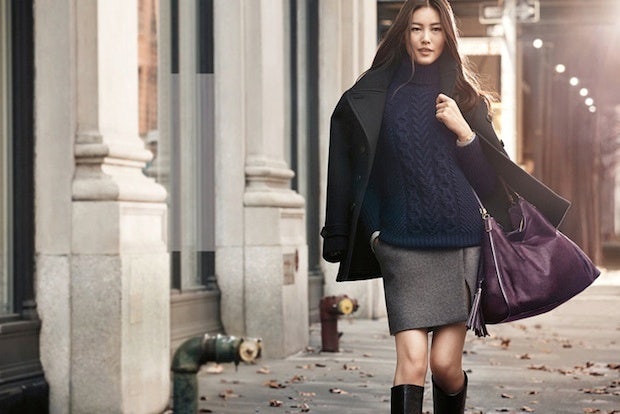
Chinese model Liu Wen in an ad for Coach. (Coach)
China’s crackdown on official luxury gifting has made a major dent in the market's growth this year, but according to Chinese media, more accessible consumer goods are doing just fine.
Bain & Company estimated that the luxury market saw only 2.5 percent growth in 2013, down from 7 percent the year before. This was due to a variety of factors, but the crackdown appears to have had the largest effect on ultra-high-end products as well as on those that were most commonly used for “gifting” or bribery purposes for officials, such as luxury watches and top-shelf spirits.
However, average, middle-class consumer goods market fared much better than luxury this year. According to a Chinese-language article in iFeng:
“Sales were stable this year,” said the employee behind the counter of a mid-range watch retailer in a shopping mall. “Business was basically at the same level as the last few years. There wasn’t much change.”
Some employees at mass-market men’s brands in the shopping mall told the reporter that although roughly the same number of people were buying clothes this year, total revenues actually increased because they were buying more this year.
According to the Department of Commerce, the latest statistics state that for the first 11 months of this year, the domestic consumer goods market continued to maintain steady acceleration and development. The total retail sales of consumer goods grew by 13 percent, furthermore, in November, it surpassed 2 trillion yuan for nominal growth of 13.7 percent year on year. For the last month of this year and for a time, consumption will remain stable and accelerate the trend, and aggregate annual value of consumer goods will grow by 13 percent.
This trend was apparent within the luxury industry itself when comparing the highest end of the market with “masstige” or “accessible” brands and product categories, which generally fared better this year. For example, accessible luxury brand Coach registered 40 percent annual sales growth in China for its most recent quarter, despite a disappointing 1 percent in North America—which was estimated to see much higher China luxury growth overall this year. Meanwhile, Michael Kors has been pursuing aggressive China expansion when more expensive brands are scaling back. Diffusion lines such as Emporio Armani and fast fashion also have their sights set on mainland expansion. The accessible luxury category of beauty has slowed, but is still estimated to have seen 10 percent growth, while product categories hit by the crackdown such as mooncakes and baijiu have gone more mid-market.
The iFeng article interviews several experts on what this means for the luxury industry, who believe that the anti-corruption campaign has removed “distortions” from the market.
According to He Jianwu, a research associate at the Development Research Center of the State Council, excessive consumption and wasteful spending distorts the market, making some of the consumer goods industry prices inflated.
According to Shiyu Peng, an Associate Professor of Economics at the Central University of Finance, in the past there has been some false prosperity in the consumer goods industry. For luxury goods, the proportion of consumption has been too high, making some of the consumer goods industry not truly reflect the real purchasing power of the people. These industries must examine their foundation for development and transition early. Although there will be pain, it is good for future development.
While these statements clearly contain rhetoric in line with the government's official stance on the crackdown, the experts do have a point that it's having an impact on hte market. Regarding the question of what brands should do to respond to these changes, Peng believes the industry is going to have to change to keep up with the times.
"The consumer goods industry, including luxury goods and everyday consumer goods, must assess and adapt to new developments in order to position themselves within their target groups.They must do in-depth analysis and market research to understand the types of goods that consumers want." He says, “As the government reforms and becomes more efficient, less corrupt, and more frugal, our luxury industry also ought to adjust itself and actively transform to fit the requirements of the market.”